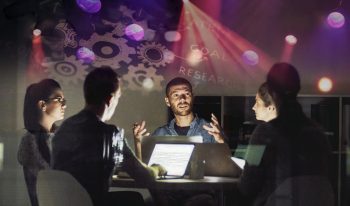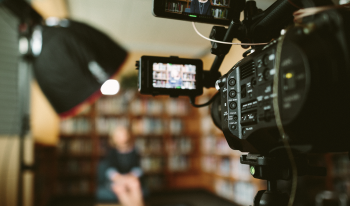When the COVID-19 quarantines rolled out in March 2020, many organizations had to make some creative decisions about how to meaningfully engage their donors and potential donors in the virtual space. Perhaps planning was already underway for a live event when leadership made the decision to go virtual or, because of guidelines for quarantining and social distancing, a live event was no longer feasible. Rather than allowing a virtual setting to impose limits on the audience’s experience, the University of California, Davis; MedStar Health; and Arizona State University were among organizations that looked at the change in venue as an opportunity to think differently about how meaningful connections can be made in a virtual space.
1. Reimagine Engagement
When the University of California, Davis approved the theme “Pure Imagination,” little did they know that lots of imagination would be required—both theirs and that of their producing partners—Advancement Resources and Wired Production Group—to overcome the challenges thrown their way by a pandemic. While there are event-planning teams that can pull off a switch from a live, in-person experience to a virtual one, the Advancement Resources team has an advantage over the others: a solid, research-based understanding of donor motivation that informs meaningful storytelling about philanthropic passions. Without food, fireworks, or the other “surprises” of a live event, it’s even more important to laser in on a strategy that speaks to the hearts of donors and potential donors.
The campaign launch team had originally envisioned “Innovation Stations” to showcase the exciting work happening on the UC Davis campus that attendees could interact with prior to the start of the main event. Instead of scrapping the idea, the team produced “Innovation Spotlights”—short videos that visually invited viewers into the exciting world of research and innovation happening on campus. The spotlights were grouped by campaign priority and strategically released in the four weeks prior to the virtual campaign launch event to drive interest and participation.
No longer tied to a physical space, a live musical performance became a music video featuring UC Davis students in creative shots on various campus locations. Video storytelling, featuring animals who had been treated at the UC Davis veterinary medicine school, invited viewers to experience the animals’ home environments. Instead of relying on light shows and live music, the team used green screens, drone shots, and other innovations to build the audience’s enthusiasm.
2. Amplify Your Organization’s Reach
There’s an old saying that travel broadens one’s world. The same is true of a good virtual link. MedStar Health leveraged their reach by partnering with Advancement Resources to conduct virtual salon events, modeled after traditional salon events—intimate gatherings, typically hosted in someone’s home, for the purpose of exploring and sharing ideas. The MedStar advancement team quickly discovered that they were no longer bound by the limitations of a physical space. Clinicians, hospital leadership, and donors could conveniently gather no matter where they were physically located.
Keeping the list of attendees small preserved the intimate nature of a traditional salon event and highlighted the prestige of an invitation. Together, the two teams created a strategy that would speak to the hearts of donors. During the live, virtual event, Advancement Resources handled the technical aspects, so participants could focus on connecting through the exchange of ideas. MedStar has successfully used—and continues to use—virtual salon events to stir donors’ interest and excitement about a variety of capital and research priorities.
3. Boost Participation
While it’s easy to focus on the can’ts of a virtual event, virtually launching or closing a campaign can yield amazing results in terms of attendance. Open to any viewer anywhere, using the virtual space is a perfect way to create awareness for an organization’s mission, funding priorities, and impact with all potential donors. On the initial livestream of the UC Davis campaign kickoff, nearly 1,000 viewers participated. By the end of the weekend, viewership had tripled—and was quadruple the number of attendees originally planned for the live event. Viewers took in the event from India to Greece and other far-flung locations. Subtitles in Chinese and Spanish broke down language barriers.
Viewership for the campaign close at Arizona State University registered in the thousands during the initial livestream. Donor and alumni ZoomTM “happy hours” were organized for many of the colleges and programs, which built excitement for the main event, provided specific information about the impact of the campaign on the respective colleges, and furnished time for donors and alumni to socialize.
4. Leverage the Chat Box
The chat feature during any virtual event plays an integral part in donor engagement strategy—and that was true for the virtual campaign events hosted by UC Davis and ASU. Interested viewers were able to have their questions answered in real time, and the development team members had more targeted engagement with those who asked specific questions. After the events, development professionals were able to begin conversations with both new potential donors and those donors with whom they hadn’t engaged for a while—all driven by strategic monitoring of the questions and comments that flowed through the chat box.
We are all looking forward to a time when we can again physically come together to celebrate joyous events such as achieving a campaign goal. However, don’t lose sight of the value of engaging donors and potential donors in a virtual setting. That virtual link is one more powerful way to drive donor commitment both now and in the future.
The creative services team at Advancement Resources stands ready to help you with all things virtual and video—whether it be a donor event with a small number of participants or a celebratory event with thousands of viewers. Start a conversation with Lynnea Handley, Vice President, Creative Services at Advancement Resources at lhandley@advancementresources.org to explore your options.
For more information on donor-centric campaigns, download Campaign Events—A New Approach


